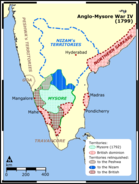The Anglo–Mysore Wars were a series of wars fought in India over the last three decades of the 18th century between the Kingdom of Mysore and the British East India Company, represented chiefly by the Madras Presidency. The fourth war resulted in the overthrow of the house of Hyder Ali and Tipu Sultan (who was killed in the final war, in 1799), and the dismantlement of Mysore to the benefit of the British and their allies.

Hyder Ali in 1762, incorrectly described as "Commander in Chief of the Marathas. At the head of his army in the war against the British in India". (French painting)
The First Anglo–Mysore War (1767–1769) saw Hyder Ali gain some measure of success against the British but suffering heavy defeats at the hands of the Marathas. Hyder Ali's alliance with the Nizam of Hyderabad against the British too was a failure owing to defeats of their combined power against the British and later the spread of mutual suspicion between the two Islamic powers. The Kingdom of Mysore regained some of its lost lands and had to relinquish many territories to the south of Mysore to the British.
The Second Anglo–Mysore War (1780–1784) witnessed bloodier battles with fortunes fluctuating between the contesting powers. This war saw the rise of Sir Eyre Coote, the British commander who repeatedly defeated Hyder Ali and his superior army. The war ended in 1784 with the Treaty of Mangalore, at which both sides agreed to restore the others' lands to the status quo ante bellum.
In the Third Anglo–Mysore War (1789–1792), Tipu Sultan, the ruler of Mysore and an ally of France, invaded the nearby state of Travancore in 1789, which was a British ally. The resultant war lasted three years and was a resounding defeat for Mysore. The war ended after the 1792 siege of Seringapatam and the signing of the Treaty of Seringapatam according to which Tipu had to surrender half of his kingdom to the British East India Company and its allies.
The Fourth Anglo–Mysore War (1799) saw the defeat of Tipu Sultan and further reductions in Mysorean territory. Mysore's alliance with the French was seen as a threat to the East India Company and Mysore was attacked from all four sides. Tipu's troops were outnumbered 4:1 in this war. Mysore had only 35,000 soldiers, whereas the British commanded 60,000 troops. The Nizam of Hyderabad and the Marathas launched an invasion from the north. The British won a decisive victory at the Battle of Seringapatam in 1799. Tipu was killed during the defence of the city. Much of the remaining Mysorean territory was annexed by the British, the Nizam and the Marathas. The remaining core, around Mysore and Seringapatam, was restored to the Indian prince belonging to the Wodeyar dynasty, whose forefathers had been the actual rulers before Hyder Ali became the de facto ruler. The Wodeyars ruled the remnant state of Mysore until 1947 when it joined the Union of India.
After the Battles of Plassey (1757) and Buxar (1764) which established British dominion over East India, the Anglo-Mysore wars (1766–1799), the Anglo–Maratha Wars (1775–1818), and finally the Anglo-Sikh Wars (1845–1849) consolidated the British claim over South Asia, resulting in the British Empire in India, though resistance among various groups such as the Afghans and the Burmese would last well into the 1880s.
Arul of Rockets[]
The Mysore rockets utilized by Hyder Ali during the Battle of Pollilur were much more advanced than the British East India Company had previously seen, chiefly because of the use of iron tubes for holding the propellant, this enabled higher thrust and longer range for the missile (up to 2 km range). After Tipu Sultan's eventual defeat in the Fourth Anglo-Mysore War and the capture of the Mysore iron rockets, they were influential in British rocket development, inspiring the Congreve rocket, which was soon put into use in the Napoleonic Wars.[1]
References[]
- ↑ Roddam Narasimha (1985). Rockets in Mysore and Britain, 1750–1850 A.D. National Aeronautical Laboratory and Indian Institute of Science.
- Regan S. Gidwani, The Sword of Tipu Sultan.
The original article can be found at Anglo-Mysore Wars and the edit history here.




